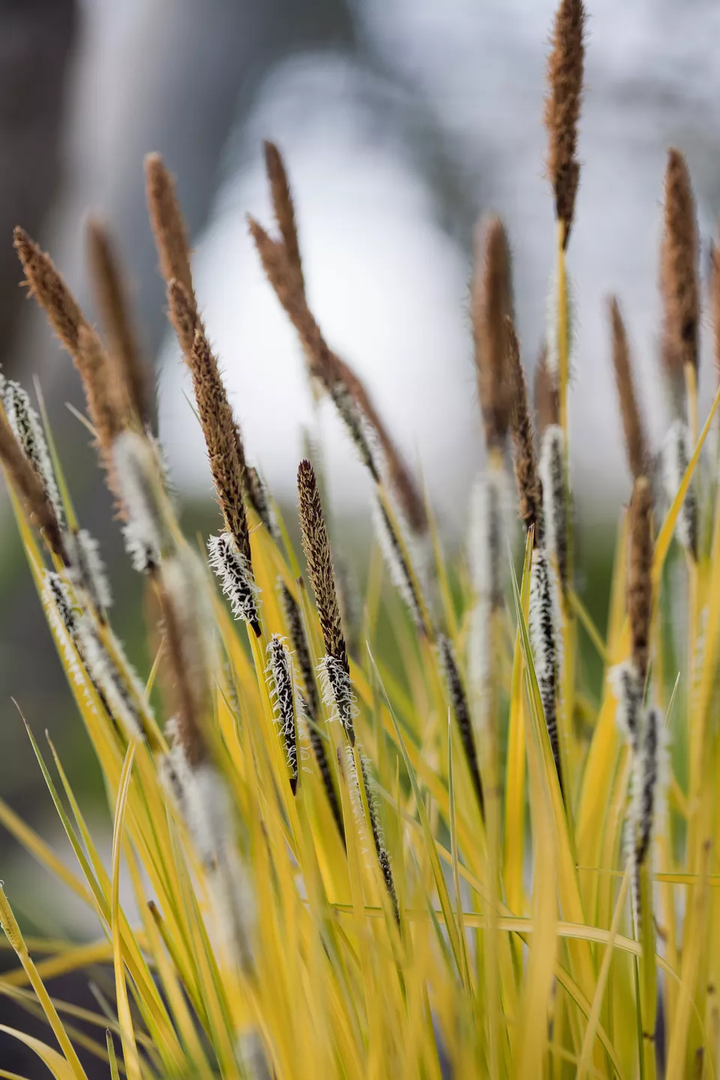Tussock Sedge (Carex stricta) is a rhizomatous evergreen sedge that forms a dense "tussock" of grassy, rich blue-green leaves. Also known as "upright sedge," this variety hybridizes with many other Carex species in the Cyperaceae family.
While spreading by rhizomes to form large colonies, this plant grows one to three feet tall and one to two feet wide. "Carex" in Latin refers to the sharp leaves and stem edges found on most species plants. Rushes are round but sedges have edges. Handling the plant with gloves to prevent any accidental cuts could be a good idea.
As leaves die, they form elevated clumps around the base. Green flower spikes appear above the foliage in late spring, and the blooms become chocolate or reddish-brown as they mature. The fruit ripens in August and the foliage provides winter interest into the cooler months.
This low-maintenance perennial tolerates deer and erosion. Native to wet sites in Eastern North America, it thrives in marshes, swamps, bogs, swales, meadows, creek margins, low wet fields, as well as shores of rivers or lakes.
Tussock Sedge is perfect for growing at the edges of shady ponds or in gardens that are prone to flooding, and it also does well grown in containers with other water-loving species.
Botanical Name:
Carex stricta
Common Names:
Tussock Sedge, Upright Sedge
Plant Type:
Rhizomatous evergreen
Mature Size:
One to three feet tall and one to two feet wide
Sun Exposure:
Full sun to part shade
Soil Type:
Wet clay
Soil pH:
Acidic to neutral
Bloom Time:
Late spring
Flower Color:
Reddish brown
Hardiness Zones:
3 - 8, USA
Native Area:
Eastern North America
Toxicity:
Non-toxic
Tussock Sedge Care
To welcome this evergreen to your garden, plant in a moist to wet area such as a rain garden. Consider a low spot as the tussock sedge can thrive in two to three-inch deep standing water or any upland location where soils are consistently moist.
Light
Tussock sedge can be grown as a groundcover for shady areas. In sunnier areas, this grassy perennial makes a good accent plant. Overall, this sedge prefers full sun, though it will tolerate part shade.
Soil
Plant in moist to wet, acidic or neutral, peat, muck or mineral soil.
Water
Tussock sedge is good to plant near ponds and streams where the foliage can be reflected in the water. It provides good cover for birds and frogs. Able to tolerate seasonal flooding, this plant grows well in wet low spots and water margins.
Is Tussock Sedge Toxic?
The little research available shows that the tussock sedge is not toxic. As always, take extra caution and be mindful of any symptoms that may occur if you or a pet should come into contact with any unfamiliar plant.
Pruning
Raking out old dead foliage from the clumps can help with the aesthetics. It will also recover well if you decide to cut it back in fall.
Propagating Tussock Sedge
Upright sedge usually regenerates through rhizomes. Two types of rhizomes can grow from this variety of sedge: long ones that branch and produce distant plants, as well as short ones that produce "culms", which are offset from the parent plant.
Note: When upright sedge plants come from very wet habitats, they tend to have what is called "cespitose stems," which are producing clumps of stems and poorly formed rhizomes. Yet plants from drier habitats usually have long rhizomes and do not produce clumps of stems.
How to Grow Tussock Sedge from Seed
This plant can also be propagated by seed. In Wisconsin, a study was done in which seeds were collected and planted within two weeks. These seeds were compared with seeds collected and stored in a cold location for one year.
The seeds planted sooner had a 70 to 95 per cent germination rate, while the one-year-old seeds showed less than 15 per cent germination.
These results, among others, prove that tussock sedge seeds should be planted after being freshly harvested.
If you are harvesting your own seeds, do this as soon as they ripen. This will be in the fall when they turn from green to brown
Common Pests/Diseases
There are no serious pest or disease issues for tussock sedge. It is overall very easy to grow and of no interest to deer while becoming a favorite of many a rain garden owner today.
You Might Like ...